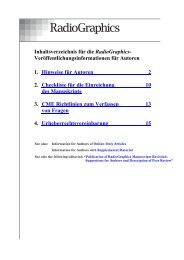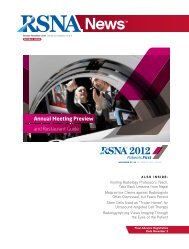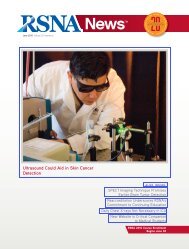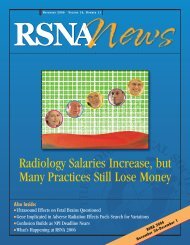RSNA 2009 Meeting Preview - Radiological Society of North America
RSNA 2009 Meeting Preview - Radiological Society of North America
RSNA 2009 Meeting Preview - Radiological Society of North America
Create successful ePaper yourself
Turn your PDF publications into a flip-book with our unique Google optimized e-Paper software.
protein 90 (Hsp90) inhibitor that is<br />
known to decrease HER2 expression.<br />
PET scans were performed before and<br />
after 17-DMAG treatment.<br />
Researchers found that HER2 levels<br />
were reduced by 71 percent in mice<br />
with tumors that expressed very high<br />
levels <strong>of</strong> HER2 and by 33 percent in<br />
mice with tumors that expressed high<br />
levels <strong>of</strong> HER2 compared with mice<br />
that did not receive 17-DMAG.<br />
“Our approach using PET for in<br />
vivo assessment <strong>of</strong> HER2 expression<br />
may aid diagnosis <strong>of</strong> breast cancer and<br />
improve the outcome <strong>of</strong> HER2-targeted<br />
therapies,” said Dr. Capala. “Several<br />
molecular probes based on antibodies<br />
have recently been tested in experimental<br />
animal tumor models, but a PET<br />
tracer for routine clinical use has not<br />
yet been developed.”<br />
Invasive Method Has Drawbacks<br />
Although invasive tissue sampling is<br />
currently the gold standard for investigating<br />
HER2 tumor levels, the method<br />
has a number <strong>of</strong> obvious drawbacks<br />
including restricting analysis to only<br />
the sampled cells at a single time,<br />
according to Peter M. Smith-Jones,<br />
Ph.D., associate attending radiochemist<br />
at Memorial Sloan-Kettering Cancer<br />
Center in New York and creator <strong>of</strong> a<br />
probe developed to study the pharmacodynamics<br />
<strong>of</strong> the therapeutic 17-AAG,<br />
another Hsp90 inhibitor, on HER2.<br />
“This PET technique allows you to<br />
scan the whole patient for multiple sites<br />
and can be repeated within 24 hours so<br />
you can quickly monitor the drug effects<br />
on the tumor,” said Dr. Smith-Jones.<br />
Along with facilitating the selection<br />
<strong>of</strong> patients for HER2-targeted<br />
therapy and providing information on<br />
the immediate response to therapeutic<br />
intervention, the PET imaging technique<br />
would reduce the number <strong>of</strong><br />
biopsies and cut back on the number <strong>of</strong><br />
false-negative or false-positive results<br />
associated with invasive methods, said<br />
Dr. Whitman.<br />
He stresses that the technique’s<br />
monitoring capability would be espe-<br />
Researchers at the<br />
National Institutes<br />
<strong>of</strong> Health (NIH)<br />
used PET and a<br />
specially developed<br />
radioactive compound<br />
(fluorine-18)<br />
attached to an<br />
Affibody ® molecule<br />
to image human<br />
epidermal growth<br />
factor receptor type<br />
2 (HER2), a wellestablished<br />
tumor<br />
biomarker that is<br />
overexpressed in a<br />
wide variety <strong>of</strong> carcinomas.<br />
(shown)<br />
Affibody molecules are much smaller than antibodies or antibody<br />
fragments, but the size <strong>of</strong> their binding surfaces is comparable.<br />
cially advantageous in terms <strong>of</strong> administering<br />
the best treatments as early<br />
as possible. “Sometimes our ability<br />
to monitor response to therapy seems<br />
primitive and <strong>of</strong>ten not that precise or<br />
sensitive,” said Dr. Whitman.<br />
“Using conventional response criteria,<br />
it can take months until the physician<br />
can definitively say that the patient<br />
is responding to a drug regime,” added<br />
Dr. Smith-Jones. “This scan should<br />
quickly help find the right drug for the<br />
right patient.”<br />
PET Research Continues<br />
While using PET and MR imaging<br />
with tracers that target receptors is still<br />
in the early stages, the technique “will<br />
make tremendous progress in the next<br />
five to 10 years,” said Dr. Whitman,<br />
who said it is part <strong>of</strong> a general trend<br />
toward personalized medicine. “Parallel<br />
to that, we’re discovering various<br />
pathways and receptors and there may<br />
be more entities such as HER2 that we<br />
will discover in the future.”<br />
In continuing his research on the<br />
technique, Dr. Capala and colleagues<br />
are studying whether it can be used to<br />
target HER2 and epidermal growth factor<br />
receptor for diagnoses and therapy<br />
<strong>of</strong> metastatic lesions in the brain and<br />
brain tumors.<br />
Ultimately, he said, “PET may<br />
provide a considerable advantage and<br />
become an attractive alternative for<br />
assessing HER2 expression quantitatively,<br />
objectively yet noninvasively,<br />
allowing several scans to be performed<br />
over the course <strong>of</strong> therapy.” ■<br />
<strong>RSNA</strong>NEWS. ORG<br />
Image courtesy <strong>of</strong> the National Institutes <strong>of</strong> Health<br />
Learn More<br />
■ An abstract <strong>of</strong> “Changes in HER2 Expression<br />
in Breast Cancer Xenografts after<br />
Therapy Can be Quantified Using PET and<br />
18F-Labeled Affibody Molecules,” published<br />
in the July issue <strong>of</strong> the Journal <strong>of</strong> Nuclear<br />
Medicine, is available at http://jnm.snm<br />
journals.org/cgi/content/abstract/50/7/1131.<br />
❚<br />
Molecular Imaging at<br />
<strong>RSNA</strong> <strong>2009</strong><br />
A<br />
Molecular Imaging Symposium will be<br />
among the multisession courses<br />
<strong>of</strong>fered at <strong>RSNA</strong> <strong>2009</strong>. The courses, to be<br />
held Wednesday, Dec. 2, include “Molecular<br />
Imaging: Overview<br />
and the Basics,”<br />
moderated by Daniel<br />
C. Sullivan, M.D., as<br />
well as presentations<br />
on molecular imaging<br />
in oncology, cardiovascular disease and<br />
brain disorders.<br />
Registration for these and all other<br />
<strong>RSNA</strong> <strong>2009</strong> courses is under way at<br />
<strong>RSNA</strong><strong>2009</strong>.<strong>RSNA</strong>.org.<br />
<strong>RSNA</strong> NEWS<br />
13






